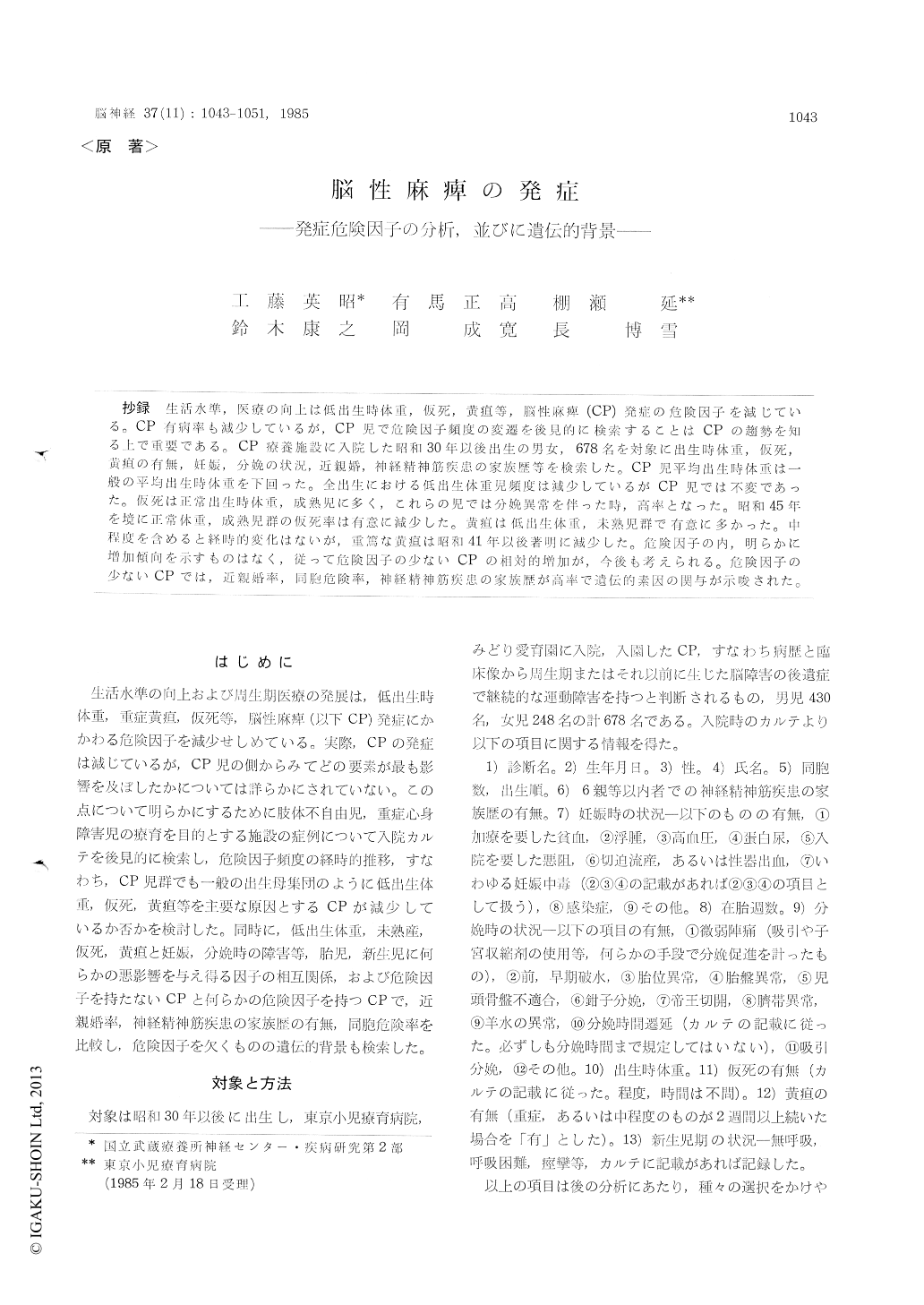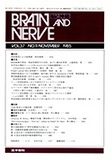Japanese
English
- 有料閲覧
- Abstract 文献概要
- 1ページ目 Look Inside
抄録 生活水準,医療の向上は低出生時体重,仮死,黄疸等,脳性麻痺(CP)発症の危険因子を減じている。CP有病率も減少しているが,CP児で危険因子頻度の変遷を後見的に検索することはCPの趨勢を知る上で重要である。CP療養施設に入院した昭和30年以後出生の男女,678名を対象に出生時体重,仮死,黄疸の有無,妊娠,分娩の状況,近親婚,神経精神筋疾患の家族歴等を検索した。CP児平均出生時体重は一般の平均出生時体重を下回った。全出生における低出生体重児頻度は減少しているがCP児では不変であった。仮死は正常出生時体重,成熟児に多く,これらの児では分娩異常を伴った時,高率となった。昭和45年を境に正常体重,成熟児群の仮死率は有意に減少した。黄疸は低出生体重,未熟児群で有意に多かった。中程度を含めると経時的変化はないが,重篤な黄疸は昭和41年以後著明に減少した。危険因子の内,明らかに増加傾向を示すものはなく,従って危険因子の少ないCPの相対的増加が,今後も考えられる。危険因子の少ないCPでは,近親婚率,同胞危険率,神経精神筋疾患の家族歴が高率で遺伝的素因の関与が示唆された。
In the last 30 years the prevalence rate of cere-bral palsy (CP) has remarkably decreased in Japan. The decrease is arbitrarily attributed to the re-duced frequency of such risk factors for CP, as low birthweight, severe asphyxia, and kernicterus in the neonatal period. However, there is no sta-tistical data providing the evidence that CP pa-tients complicating these risk factors have actually decreased so far. In order to make clear the bases of the decrease in prevalence of CP, we examined the changing patterns in the suggested cause of CP, experienced in the last 30 years. The investigation included the maternal condition of pregnancy and delivery, in relation to the neonatal risk factors, and genetic background of the family. In CP, low birthweight babies of 2500 gm or less were common (36.9%) and the meanbirthweight (2689 gm) was obviously smaller than that of general population. In spite of the constant decline of the incidence of low birthweight babies in the general populationin in the last 30 years, the ratio of low birthweight to total births in CP group had not changed in this study period. It was concluded that the low birthweight follow-ing premature birth is still an important predis-posing factor of CP. Asphyxia was frequently seen in the CP population. The rate of asphyxia was significantly higher in the group with a nor-mal birthweight more than 2501 gm (58.4%), or gestational weeks longer than 36 weeks (57.7%), comparing with that of low birthweight (41.1%), or premature (40.7%) group. In the last 14 years,the rate of asphyxia was apparently reduced in the group with normal birthweight (before 1969; 65.6%, after 1970; 44.6%) or gestational weeks longer than 36 weeks (before 1969; 65.8%, after 1970; 43.5%), while it was unchanged in the low birthweight or premature group. When the de-livery was abnormal, asphyxia increased in the mature group. The condition of of delivery less influenced the frequency of asphyxia in the premature. The frequency of jaundice of moderate or severe degree was high in low birthweigh group, and the incidence was not so changed in the study period. It decreased slightly in the group with birthweight more than 2501 gm (before 1969; 35.7%, after 1970; 24.8%). Jaundice of se-vere degree, possibly associated with kernicterus, decreased significantly after 1966. The rate of consanguinity of parents of CP was 4.8%. The rate tended to be high in the group with less risk factors. It was 17.6%, in the group with birthweight more than 2501 gm, normal pregnancy and delivery, and with neither asphyxia nor jaun-dice. Sib risk was 2.4%. The risk also tended to be high in the group without any risk factors, and any troubles during pregnancy and delivery (15.8%). The family history about neuro-psycho-muscular diseases, including sib patients, was seen in 6.4% of families with CP. In conclusion, the frequency of some risk factors in the CP grouphad been gradually changed in the last 30 years, but no risk factors had actually increased. These result suggest the possibility that the CP with less risk factors will increase in the future. In our study the number of these CP was too small for precise analysis of genetical factors in CP. However, several tendencies, seen in the study of sib risk, consanguinity, or family history about neuro-psycho-muscular diseases, suggest that ge-netical factors might take part in CP.

Copyright © 1985, Igaku-Shoin Ltd. All rights reserved.


